Dodge Viper GT2 and
Dodge Viper ACR (1998-99)
Dodge Viper GT2
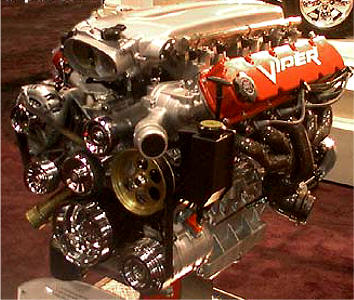 In
1995, Chrysler introduced the Dodge Viper GTS-R, a limited-production racing car
strictly intended for worldwide GT-class competition. The standard powertrain
was a 525-horsepower 8.0 liter V-10, with 650- or 750-horsepower engines
available as an option. It clinched the 1997 FIA GT2 championship and the 1998
24 Hours of Le Mans in the GT2 Class. In
1995, Chrysler introduced the Dodge Viper GTS-R, a limited-production racing car
strictly intended for worldwide GT-class competition. The standard powertrain
was a 525-horsepower 8.0 liter V-10, with 650- or 750-horsepower engines
available as an option. It clinched the 1997 FIA GT2 championship and the 1998
24 Hours of Le Mans in the GT2 Class.
To publicize this achievement, Chrysler built 100 street-legal
1998 GT2 Championship Edition Vipers. It will be painted the same way as the
GTS-R, with an aerodynamics package of fascia dive plates, black sill ground
effects, a front splitter and rear wing. An enhanced powertrain (see the ACR
description) raised performance to 460 hp @ 5200 rpm from 450 hp @5200 rpm and
increased torque to 500 ft/lb at 3600 rpm from 490 ft/lb at 3700 rpm.
Special badging and graphics include a "Viper GTS-R" banner on
the windshield and hood sides and an American flag appears on the upper quarter
panel with "FIA GT2 Champion" underneath. 18-inch Michelin MXX3 tires and unique
18-inch one-piece wheels complete with a chrome Viper snake head logo on the
center caps complete the visibility options.
The interior is black with blue accents on door inserts,
bolsters, and the center console and parking brake. A dash plaque highlighting
the commemorative series and vehicle identification number (VIN) is mounted on
the center console. The interior comes with a five-point restraint system,
identical to the restraint system used by Viper Team ORECA, the France-based
factory race team that captured both championships. The retail price was $85,200
including destination.
Dodge Viper ACR
The 1999 Dodge Viper ACR (American Club Racer) is a hybrid of
the GTS-R and the standard Viper. About 100 to 200 of these special edition
Vipers will be available in the first quarter through Dodge dealers. The major
changes to make these vehicles race-ready were more power, lower weight, and
refined handling:
- Smooth intake hoses and a K&N air filter element
increased air flow to add 10 horsepower.
- 60 pounds were cut by removing the audio system, air
conditioning, and fog lights (brake cooling ducts can be put into the
openings).
- Suspension components have been replaced by GTS-R
racing units with Meritor (formerly Rockwell) springs. Michelin Pilot
Sport high-performance radials (P275/35ZR18 front, P335/30ZR18 rear)
mount on one-piece 18-inch BBS wheels for improved traction.
The ACR will have the interior enhancements of standard
Vipers: power sideview mirrors, cloth-covered sun visors, a satin aluminum
finish on gauge trim rings, parking brake handle and release button, shift lever
shaft, gearshift knob and inside door release handles.
The ACR concept started with the Dodge Neon; the idea is to
provide racing enthusiasts with a reasonably priced entry to Showroom Stock
classes. Neon ACRs won the Sports Car Club of America (SCCA) Showroom Stock/C
class in 1995, 1996 and 1997. Neon drivers also scored 127 wins and 311
top-three finishes in 216 national events; one Pro Rally production-class
championship and five Solo Two national championships in 1997.
Special Dodge Viper ACR Equipment
Special ACR badging and graphics including commemorative dash
plate. Five-point restraint system, K&N air cleaner, smooth air cleaner hoses,
one-piece 18-inch BBS wheels with chrome Viper Head center caps and Michelin
Pilot Sport tires. Vents replace driving lamps. A/C system/compressor deleted,
audio system deleted, Koni racing shocks and Meritor springs. A/C and audio
systems are optional
Instrumentation
Analog speedometer, odometer, trip odometer, tachometer,
voltmeter, oil pressure, coolant temperature and fuel gauges. Low oil pressure,
coolant temperature, air bags, high beam, seatbelt, brake system and service
engine soon, 2-3 shift lockout, battery voltage, door ajar, turn signals and
security alarm indicator lights
Body And Frame
Resin transfer molded (RTM) composite body with sheet-molded
compound (SMC) hood, backbone tubular steel space frame with center spine and
separate cowl structure. Full-access forward-opening hood/fender assembly
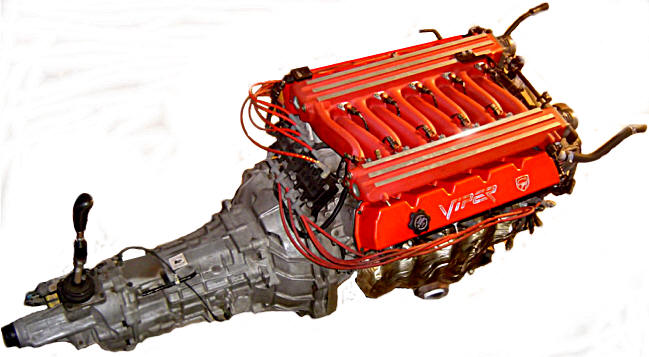
Powertrain
| Engine |
8.0-liter, OHV,
SMPI V-10 |
| Type & Description |
Ten cylinder, 90º V-type,
liquid-cooled |
| Displacement |
488 cu. In. (7,990 cc) |
| Bore x Stroke |
4.00 x 3.88 (101.6 x 98.5) |
| Valve System |
OHV, 20 valves, roller-type
hydraulic lifters, dual valve springs |
| Intake System |
Sequential, multi-port
electronic fuel injection with bottom-feed, high-impedance injectors,
aluminum ram-tuned intake manifolds with dual plenums |
| Exhaust |
Stainless steel tubular
exhaust manifolds, multiple-branch design, three-way catalytic
converters with dual oxygen sensors, two per side, feedback fuel-air
ratio control,one-piece stainless steel catalyst in sill and muffler
assembly featuring rear exit exhaust |
| Construction |
Aluminum alloy block w/cast
iron liners, aluminum alloy heads, forged-steel crankshaft, six main
bearings |
| Cooling |
Copper-core radiator,
dual-speed electric fan, front-mounted engine air-to-oil cooler |
| Compression Ratio |
9.6:1 |
| Horsepower (SAE net) |
460 bhp (343 kW) @ 5200 rpm |
| Torque (SAE net) |
500 lb. ft. (664 Nm) @ 3700
rpm |
| Max Engine Speed |
6000 rpm |
| Fuel Requirement |
Unleaded premium, 91 octane
R+M/2 |
| Oil Capacity |
8 qt. (7.6 L) |
Back to Top
of Page - Click Here

Transmission
Manual, 6-speed overdrive, synchronized in all gears;
electronic 1-4 skip-shift and reverse lockout mechanisms. Aluminum housing,
12.2-inch hydraulic single dry-disc clutch
Gear Ratios
| 1st |
2.66 |
2nd |
1.78 |
| 3rd |
1.30 |
4th |
1.00 |
| 5th |
0.74 |
6th |
0.50 |
| Effective Final Drive |
3.07 |
Overall Top Gear |
1.54 |
Chassis & Suspension
| Ground Clearance |
5.0 (127) |
| Curb Weight |
3356 lbs (1525 kg) / 3403
lbs (1547 incl. optional A/C and audio systems) |
| Weight Distribution f/r |
48/52 |
| Front |
Independent with cast
aluminum unequal-length upper and lower "A" arms. GTS-R-style Meritor
racing coil springs in threaded seats. GTS-R aluminum-bodied Koni racing
shock absorbers, double-acting, high-pressure gas-charged, externally
adjustable for bump and rebound, 1.06 in./27 mm tubular front stabilizer
bar |
| Rear |
Independent with cast
aluminum unequal-length upper and lower "A" arms with separate toe link.
GTS-R-style Meritor racing coil springs in threaded seats. GTS-R
aluminum-bodied Koni racing shock absorbers, double-acting,
high-pressure gas-charged, externally adjustable for bump and rebound,
0.86 in./22 mm tubular rear stabilizer bar |
| Steering Type |
Power-assisted rack & pinion |
| Overall Ratio |
16.7:1 |
| Turning Diameter |
40.5 ft. (12.34 m) curb to
curb |
| Steering Turns |
2.4 lock to lock |
| Wheels |
BBS forged aluminum |
| Size |
18 x 10 front, 18 x 13 rear |
| Tires, f/r |
P275/35ZR18 / P335/30ZR18
Michelin Pilot Sport high-performance radials |
| Front Brakes, Size & Type |
13.0 x 1.26 (330.5 x 32)
vented disc power assisted w/four-piston Brembo fixed caliper |
| Swept Area |
304.8 sq. in. (1966 sq. cm) |
| Rear Brakes, Size & Type |
13.0 x 0.87 (330.5 x 22)
vented disc power assisted w/single piston Brembo sliding caliper |
| Swept Area |
244.3 sq. in. (1576 sq. cm) |
| Brake Power Assist Type |
Tandem diaphragm vacuum
w/zero lost travel |
Chevrolet Corvette ZO6 vs. Dodge Viper
Let us begin by saying that Allpar is in an odd position
when it comes to comparing the Viper and Vette, because we've only driven
one of them. That said, we can make some observations.
The current generation Corvette is fresh from a 2001
redesign, which provided extra torque to the engines (and a little more
horsepower), a new top-of-the-line Z06, and upgrades to the active
suspension and traction control system. All together, the result is a car
that's a lot easier to live with than the Viper - from what we know.
The top end Z06 moves from zero to sixty in a Viper-status
four seconds flat, according to Chevrolet. Even the base automatic can get
there in five seconds, which, given the heavy clutch and stick, is an
argument for buying the automatic.
Both Viper and Vette have appropriate sounds for
high-performance muscle cars. Both have excellent handling, the Corvette's
aided by an active suspension. But only the Vette has a dry weather traction
control that makes extreme acceleration easy even for the novice driver. The
active handling also makes the car much easier to handle, an important
consideration for drivers not trained to handle racing cars.
The Corvette provides spacious accommodations for two, but
there's not much space for doodads and gizmos, and the hard-to-open center
console is very shallow. Passengers can reach back into the trunk, since
there's no partition, but nothing will stay in place just behind the seats
for very long.
While the traction control and active suspension make some
aspects of driving the Corvette easy, shifting is not one of them. It takes
time to get the feel of the heavy shifter and clutch, not to mention the
six-gear pattern. A first-to-fourth feature can sometimes get in the way, on
both cars.
Both interiors are sporty and unique. The Corvette's
instrument panel features a well-programmed and easily operated trip
computer, alphanumeric readout, and easy to read gauges. The speedometer
switches between mph and kph at the press of a button, swinging the needle
around as needed (because of this, the speedometer goes up to 200). Pressing
an options button allows the driver to set preferences for car locking, seat
movement, and other features.
The Corvette's main control drawback is the cruise control
stalk, which, in GM tradition, is hard to use, and on the same stalk as the
windshield washer, wipers, and headlights. However, when activated - or when
the speed is changed - the alphanumeric message area tells what speed it's
set for, a nice feature.
Unlike the Viper, the Corvette comes in two flavors - base
and Z06. The base model can get from zero to sixty in five seconds with an
automatic, 4.5 with a manual, making it almost the equal of the Z06. (The
Z06 also handles better). However, the base model has a smoother ride, and
an automatic transmission for those who want it - in this car, not a major
drawback.
So which is the king of the hill? In terms of being a
daily driver, rather than a racing car, we'd say probably the Corvette. Its
dry-weather traction control and active suspension make it much more
forgiving for most drivers. It's also a lot less expensive than the
limited-production Viper. On the track, though, we suspect the Viper will
continue to take top honors for the foreseeable future. |
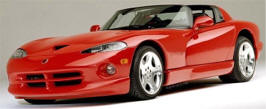
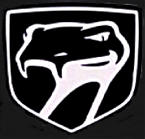

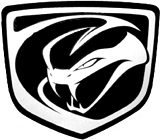
 In
1995, Chrysler introduced the Dodge Viper GTS-R, a limited-production racing car
strictly intended for worldwide GT-class competition. The standard powertrain
was a 525-horsepower 8.0 liter V-10, with 650- or 750-horsepower engines
available as an option. It clinched the 1997 FIA GT2 championship and the 1998
24 Hours of Le Mans in the GT2 Class.
In
1995, Chrysler introduced the Dodge Viper GTS-R, a limited-production racing car
strictly intended for worldwide GT-class competition. The standard powertrain
was a 525-horsepower 8.0 liter V-10, with 650- or 750-horsepower engines
available as an option. It clinched the 1997 FIA GT2 championship and the 1998
24 Hours of Le Mans in the GT2 Class.